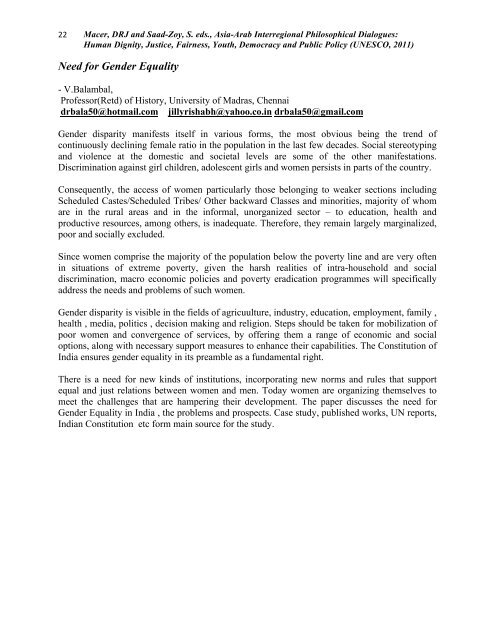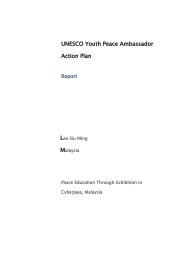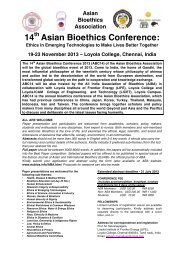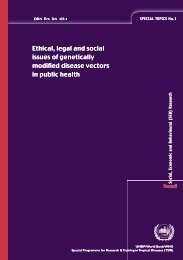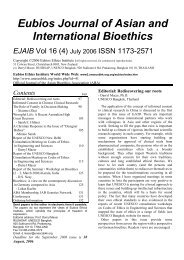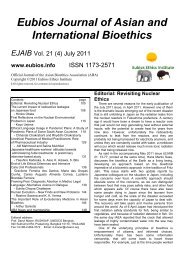Human Dignity, Justice, Fairness, Youth - Eubios Ethics Institute
Human Dignity, Justice, Fairness, Youth - Eubios Ethics Institute
Human Dignity, Justice, Fairness, Youth - Eubios Ethics Institute
You also want an ePaper? Increase the reach of your titles
YUMPU automatically turns print PDFs into web optimized ePapers that Google loves.
22 <br />
Macer, DRJ and Saad-Zoy, S. eds., Asia-Arab Interregional Philosophical Dialogues:<br />
<strong>Human</strong> <strong>Dignity</strong>, <strong>Justice</strong>, <strong>Fairness</strong>, <strong>Youth</strong>, Democracy and Public Policy (UNESCO, 2011)<br />
Need for Gender Equality<br />
- V.Balambal,<br />
Professor(Retd) of History, University of Madras, Chennai<br />
drbala50@hotmail.com jillyrishabh@yahoo.co.in drbala50@gmail.com<br />
Gender disparity manifests itself in various forms, the most obvious being the trend of<br />
continuously declining female ratio in the population in the last few decades. Social stereotyping<br />
and violence at the domestic and societal levels are some of the other manifestations.<br />
Discrimination against girl children, adolescent girls and women persists in parts of the country.<br />
Consequently, the access of women particularly those belonging to weaker sections including<br />
Scheduled Castes/Scheduled Tribes/ Other backward Classes and minorities, majority of whom<br />
are in the rural areas and in the informal, unorganized sector – to education, health and<br />
productive resources, among others, is inadequate. Therefore, they remain largely marginalized,<br />
poor and socially excluded.<br />
Since women comprise the majority of the population below the poverty line and are very often<br />
in situations of extreme poverty, given the harsh realities of intra-household and social<br />
discrimination, macro economic policies and poverty eradication programmes will specifically<br />
address the needs and problems of such women.<br />
Gender disparity is visible in the fields of agricuulture, industry, education, employment, family ,<br />
health , media, politics , decision making and religion. Steps should be taken for mobilization of<br />
poor women and convergence of services, by offering them a range of economic and social<br />
options, along with necessary support measures to enhance their capabilities. The Constitution of<br />
India ensures gender equality in its preamble as a fundamental right.<br />
There is a need for new kinds of institutions, incorporating new norms and rules that support<br />
equal and just relations between women and men. Today women are organizing themselves to<br />
meet the challenges that are hampering their development. The paper discusses the need for<br />
Gender Equality in India , the problems and prospects. Case study, published works, UN reports,<br />
Indian Constitution etc form main source for the study.


